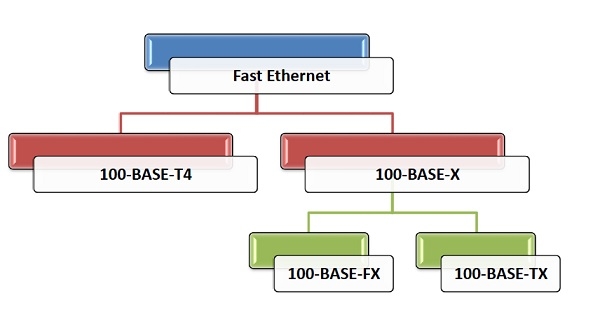
 Data Structure
Data Structure Networking
Networking RDBMS
RDBMS Operating System
Operating System Java
Java MS Excel
MS Excel iOS
iOS HTML
HTML CSS
CSS Android
Android Python
Python C Programming
C Programming C++
C++ C#
C# MongoDB
MongoDB MySQL
MySQL Javascript
Javascript PHP
PHP
- Selected Reading
- UPSC IAS Exams Notes
- Developer's Best Practices
- Questions and Answers
- Effective Resume Writing
- HR Interview Questions
- Computer Glossary
- Who is Who
The original fast Ethernet cabling
Cabling in Fast Ethernet is done using both copper wires and fiber optic cables. Fast Ethernet carries data traffic at 100 Mbps (Megabits per second) in local area networks (LAN). So, the cabling should be able to handle this data speed. Earlier copper wires cannot be used for their inability to transmit 100 Mbps data over 100 meters.
Cabling in Common Varieties of Fast Ethernet
The common varieties of fast Ethernet are 100-Base-TX, 100-BASE-FX and 100-Base-T4.

Cabling in 100-Base-T4
This has four pairs of UTP of Category 3, two of which are bi-directional and the other two are unidirectional.
Each twisted pair is capable of transmitting a maximum of 25Mbaud data. Thus the three pairs can handle a maximum of 75Mbaud data.
The maximum segment length is 100m
Cabling in 100-Base-TX
This has either two pairs of unshielded twisted pairs (UTP) category 5 wires or two shielded twisted pairs (STP) type 1 wires. One pair transmits frames from the hub to the device and the other from device to hub.
The maximum distance between the hub and station is 100m.
Cabling in 100-BASE-FX
This has two pairs of optical fibers. One pair transmits frames from the hub to the device and the other from device to hub.
The maximum distance between hub and station is 2000m.

